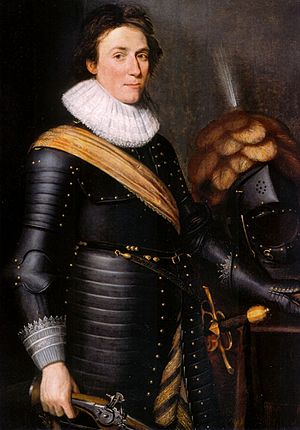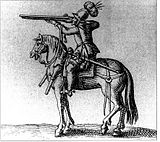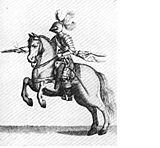Battle of Fleurus (1622) facts for kids
Quick facts for kids Battle of Fleurus |
|||||||
|---|---|---|---|---|---|---|---|
| Part of the Palatinate phase of the Thirty Years' War | |||||||
 The Battle of Fleurus 1622 by Peter Snayers |
|||||||
|
|||||||
| Belligerents | |||||||
German soldiers |
|||||||
| Commanders and leaders | |||||||
| Strength | |||||||
| up to 8,000 infantry and 6,000 cavalry (11 guns) | up to 6,000 infantry and 2,000 cavalry (4 guns) | ||||||
| Casualties and losses | |||||||
| 5,000 dead, wounded or captured | 500-1,000 dead or wounded | ||||||
The Battle of Fleurus was a major battle fought on August 29, 1622. It took place in what was then the Spanish Netherlands, which is now part of Belgium. The battle was between the Spanish army and a group of Protestant forces led by Ernst von Mansfeld and Christian of Brunswick. This fight was part of two bigger conflicts: the Eighty Years' War and the Thirty Years' War.
The battle was very fierce and bloody. In the end, the Spanish army won, which helped to keep the Catholic religion strong in Germany for a while.
Contents
Why the Battle Happened
The Armies on the Move
Before this battle, the Protestant forces had tried to help the city of Heidelberg, which was under attack. They failed, so their leader, Frederick V, Elector Palatine, decided to break up his army. However, the Dutch Republic quickly hired the soldiers of Mansfeld and Christian of Brunswick. Their new mission was to help lift the siege of Bergen-op-Zoom, a Dutch town under attack by the Spanish.
The Protestant army started their long march from Alsace, a region in France. They moved very quickly through northern France and entered the Spanish Low Countries.
The Spanish Response
At the same time, the Spanish Army of Flanders, led by Ambrogio Spinola, was busy besieging Bergen-op-Zoom. Spinola found himself in a difficult spot. A Dutch army was gathering to the east, and now Mansfeld's army was invading from the south. Spinola risked being trapped between two enemy forces.
To stop Mansfeld's army, the Spanish quickly called back Gonzalo Fernández de Córdoba. He was the commander of the Spanish army in the Palatinate. Córdoba marched his troops through tough terrain, including the Ardennes forests. He managed to intercept Mansfeld and Brunswick near the border of Brabant.
On August 27, the Protestant army's scouts met Spanish cavalry. Two days later, on August 29, they found Córdoba's army dug in and ready for battle. Córdoba had fewer cavalry, so he chose a strong defensive position north of the town of Mellet, near Fleurus. His army's sides were protected by woods. The Protestant commanders then prepared their army to try and break through the Spanish lines.
Who Fought: The Armies
Both sides had infantry (foot soldiers) and cavalry (soldiers on horseback).
The Spanish Army
The Spanish army was commanded by Gonzalo Fernández de Córdoba. It had a mix of experienced and newer soldiers.
- Infantry: The Spanish infantry included some very strong units, like the "Tercio of Naples." This unit was famous for its bravery and skill. Córdoba placed them in a key position to block the main road. Other units were also experienced, but some were garrison troops, meaning they usually guarded towns and were less used to open battle.
- Cavalry: The Spanish cavalry had both heavily armored cuirassiers and lighter arquebusiers. Many of their cavalry units were new recruits, which made Córdoba a bit worried about his army's flanks (sides).
The Protestant Army
The Protestant army was led by Ernst von Mansfeld and Christian of Brunswick. They had started with many soldiers, but their fast march had tired many out.
- Cavalry: The Protestant cavalry was very motivated and skilled. Many of these horsemen were heavily armored cuirassiers.
- Infantry: Their foot soldiers were not as well-equipped as the cavalry. They had also suffered a lot during the long march.
The Battle Begins

The battle started with a short cannon fire. Then, Mansfeld ordered his Protestant army to advance. As the German infantry moved forward, some gaps appeared in their lines. The Spanish cavalry tried to attack these weak spots, but the Protestant cavalry fought back hard.
On the Protestant left side, Christian of Brunswick gathered most of his cavalry. He hoped to break through the Spanish lines with a huge frontal attack. His first charge was pushed back by the Spanish cavalry. But Brunswick regrouped his men and charged again. The second charge managed to push back some of the Spanish horsemen.
Brunswick then turned his cavalry towards the Spanish infantry. However, his own infantry didn't support the attack well enough. The famous Spanish Tercio of Naples held its ground firmly. Spanish musketeers, hidden in the nearby woods, fired a deadly crossfire. This forced the Protestant cavalry to fall back in disarray.
In a final charge, Brunswick himself was wounded. His cavalry, losing hope, finally retreated. After five hours of fighting, around midday, Mansfeld ordered a general retreat. He planned to march his army around the Spanish position through Liège to reach Breda.
The Spanish army was too tired to chase after them. The next day, the Spanish cavalry did catch up with the Protestant army's rear guard. However, the Protestant forces managed to keep marching. They even defeated a small local army that tried to block their way. They finally reached Tongeren and then made a six-hour night march to Breda. They arrived exhausted and without much of their equipment. But within days, the Dutch supplied Mansfeld's remaining 10,000 soldiers with new gear.
What Happened Next
Because the Spanish army couldn't completely stop Brunswick and Mansfeld, the Spanish commander Spinola had to end the siege of Bergen-op-Zoom. Mansfeld and Brunswick's army only served the Dutch for three months. Their soldiers were not as disciplined as the Dutch army, so they were let go. Meanwhile, another army, led by Tilly, easily took over the Palatinate region.
Images for kids
-
The Victory of Fleurus, a painting by Vicente Carducho.
See also
 In Spanish: Batalla de Fleurus (1622) para niños
In Spanish: Batalla de Fleurus (1622) para niños




